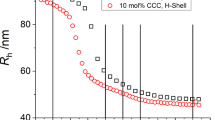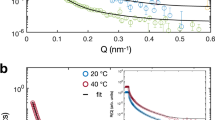Abstract
Poly(N-isopropylacrylamide) (PNIPAM)-based microgels covered with hydrophobic but water-permeable shell were used for modification of a hydrophilic substrate with the aim to provide a ‘contraphilic’ wetting behaviour, namely, to make the surface more hydrophobic in water environment (polar medium) than in dry state in air (non-polar medium). Bottom-up approach has been applied for a stepwise preparation of a structured two-component surface. Loosely packed microgels self-organised into quasiperiodic arrays were chemically grafted to the hydrophilic, functionalised substrate. Afterwards, a surface-initiated polymerisation of isoprene was performed selectively from microgels making them hydrophobic. The surface was found to be water-sensitive, as observed by in situ AFM measurements. The surface fraction of the hydrophobic component increased from 13% in the dry state up to 25% in water due to swelling of the microgels. However, small contraphilic effect was recorded by water contact angle measurements because of a moderate lateral swelling of the core-shell microgels and due to a fast swelling of the microgels already upon the measurements.








Similar content being viewed by others
References
Schmaljohann D, Oswald J, Jørgensen B, Nitschke M, Beyerlein D, Werner C (2003) Thermo-responsive PNiAAm-g-PEG films for controlled cell detachment. Biomacromolecules 4:1733–1739
Hoare T, Pelton R (2007) Engineering glucose swelling responses in poly(N-isopropylacrylamide)-based microgels. Macromolecules 40:670–678
Thies C (1996) In: Benita S (ed) Drugs and the pharmaceutical sciences, vol 73. Marcel Dekker, New York
Chen CW, Chen MQ, Serizawa T, Akashi M (1998) In situ synthesis and the catalytic properties of platinum colloids on polystyrene microspheres with surface-grafted poly(N-isopropylacrylamide). Chem Commun 7:831–832
Das M, Zhang H, Kumacheva E (2006) Microgels: old materials with new applications. Annu Rev Mater Res 36:117–142
Suzuki D, McGrath JG, Kawaguchi H, Lyon LA (2007) Colloidal crystals of thermosensitive, core/shell hybrid microgels. J Phys Chem C 111:5667–5672
Zhang G, Wang D, Gu ZZ, Hartmann J, Möhwald H (2005) Two-dimensional non-close-packing arrays derived from self-assembly of biomineralized hydrogel spheres and their patterning applications. Chem Mater 17:5268–5274
Jiang P, McFariand MJ (2005) Wafer-scale periodic nanohole arrays templated from two-dimensional nonclose-packed colloidal crystals. J Am Chem Soc 127:3710–3711
Retsos H, Gorodyska G, Kiriy A, Stamm M, Creton C (2005) Adhesion between chemically heterogeneous switchable polymeric brushes and an elastomeric adhesive. Langmuir 21:7722–7725
Retsos H, Senkovskyy V, Kiriy A, Stamm M, Feldstein M, Creton C (2006) Controlling tack with bicomponent polymer brushes. Adv Mater 18:2624–2628
Ruckenstein E, Lee SHJ (1987) Surface restructuring of polymers. Colloid Interface Sci 120:529–536
Lee SH, Ruckenstein EJ (1987) Stability of polymeric surfaces subjected to ultraviolet irradiation. Colloid Interface Sci 117:172–178
Hopken J, Moller M (1992) On the morphology of (perfluoroalkyl)alkanes. Macromolecules 25:2482–2489
Vaidya A, Chaudhury MK (2002) Synthesis and surface properties of environmentally responsive segmented polyurethanes. J Colloid Interface Sci 249:235–245
Senshu K, Yamashita Sh, Mori H, Ito M, Hirao A, Nakahama S (1999) Time-resolved surface rearrangements of poly(2-hydroxyethyl methacrylate-block-isoprene) in response to environmental changes. Langmuir 15:1754–1762
Mori H, Hirao A, Nakahama S, Senshu K (1994) Synthesis and characterization of hydrophilic hydrophobic block-copolymers containing poly(2.3-dihydroxypropyl methacrylate). Macromolecules 27:4093–4100
Pientka Z, Oike H, Tezuka Y (1999) Atomic force microscopy study of environmental responses on poly(vinyl alcohol)-graft-polystyrene surfaces. Langmuir 15:3197–3201
Minko S, Muller M, Motornov M, Nitschke M, Grundke K, Stamm M (2003) Two-level structured self-adaptive surfaces with reversibly tunable properties. J Am Chem Soc 125:3896–3900
Senkovskyy V, Khanduyeva N, Komber H, Oertel U, Stamm M, Kuckling D, Kiriy A (2007) Conductive polymer brushes of regioregular head-to-tail poly(3-alkylthiophenes) via catalyst-transfer surface-initiated polycondensation. J Am Chem Soc 129:6626–6632
Senkovskyy V, Tkachov R, Beryozkina T, Komber H, Oertel U, Horecha M, Bocharova V, Stamm M, Gevorgyan SA, Krebs FC, Kiriy A (2009) “Hairy” poly(3-hexylthiophene) particles prepared via surface-initiated kumada catalyst-transfer polycondensation. J Am Chem Soc 131:16445–16453
Hemmerle J, Roucoules V, Fleith G, Nardin M, Ball V, Lavalle P, Marie P, Voegel JC, Schaaf P (2005) Mechanically responsive films of variable hydrophobicity made of polyelectrolyte multilayers. Langmuir 21:10328–10331
Tamber H, Johansen P, Merkle HP, Gander B (2005) Formulation aspects of biodegradable polymeric microspheres for antigen delivery. Adv Drug Deliv Rev 57:357–376
Hammer DA, Discher DE (2001) Synthetic cells—self-assembling polymer membranes and bioadhesive colloids. Annu Rev Mater Sci 31:387–404
Tsukruk V, Luzinov I, Larson K, Li S, McGrath DV (2001) Intralayer reorganization of photochromic molecular films. J Mater Sci Lett 20:873–876
Caruso F, Caruso RA, Mohwald H (1998) Nanoengineering of inorganic and hybrid hollow spheres by colloidal templating. Science 282:1111–1114
Donath E, Sukhorukov GB, Caruso F, Davis S (1998) Novel hollow polymer shells by colloid-templated assembly of polyelectrolytes. Angew Chem Int Ed 37:2202–2205
Johnson SA, Ollivier PJ, Mallouk TE (1999) Ordered mesoporous polymers of tunable pore size from colloidal silica templates. Science 283:963–965
Bronich TK, Ouyang M, Kabanov VA, Eisenberg A, Szoka FC, Kabanov AV (2002) Synthesis of vesicles on polymer template. J Am Chem Soc 124:11872–11873
Holmesfarley SR, Reamey RH, Nuzzo R, McCarthy TJ, Whitesides GM (1987) Reconstruction of the interphase of oxidatively functionalized polyethylene and derivatives on heating. Langmuir 3:799–815
Dowding PJ, Atkin R, Vincent B, Bouillot P (2004) Oil core-polymer shell microcapsules prepared by internal phase separation from emulsion droplets: I. Characterization and release rates for microcapsules with polystyrene shells. Langmuir 20:11374–11379
Dinsmore AD, Hsu MG, Nikolaides MG, Marques M, Bausch AR, Weitz DA (2002) Colloidosomes: selectively permeable capsules composed of colloidal particles. Science 298:1006–1009
Hotz J, Meier W (1998) Vesicle-templated polymer hollow spheres. Langmuir 14:1031–1036
Qian J, Wu FP (2007) Synthesis of thermosensitive hollow spheres via a one-pot process. Chem Mater 19:5839–5841
Peyratout CS, Dahne L (2004) Tailor-made polyelectrolyte microcapsules: from multilayers to smart containers. Angew Chem Int Ed 43:3762–3783
Velev OD, Furusawa K (1996) Assembly of latex particles by using emulsion droplets as templates: 1. Microstructured hollow spheres. Langmuir 12:2374–2384
Zhao B, Brittain WJ (1999) Synthesis of tethered polystyrene-block-poly(methyl methacrylate) monolayer on a silicate substrate by sequential carbocationic polymerization and atom transfer radical polymerization. J Am Chem Soc 121:3557–3558
Sidorenko A, Minko S, Schenk-Meuser K, Duschner H, Stamm M (1999) Switching of polymer brushes. Langmuir 15:8349–8355
Tiarks F, Landfester K, Antonietti M (2001) Preparation of polymeric nanocapsules by miniemulsion polymerization. Langmuir 17:908–918
Makal U, Wynne KJ (2005) Water induced hydrophobic surface. Langmuir 21:3742–3745
Makal U, Uslu N, Wynne KJ (2007) Water makes it hydrophobic: contraphilic wetting for polyurethanes with soft blocks having semifluorinated and 5, 5-dimethylhydantoin side chains. Langmuir 23:209–216
Cassie ABD (1948) Contact angles. Discuss Faraday Soc 3:11–16
Wenzel RN (1936) Resistance of solid surfaces to wetting by water. Ind Eng Chem 28:988–994
Lamb DJ, Anstey JF, Fellows CM, Monteiro MJ, Gilbert RJ (2001) Modification of natural and artificial polymer colloids by “topology-controlled” emulsion polymerization. Biomacromolecules 2:518–525
Horcas I, Fernandez R, Gomez-Rodriguez JM, Colchero J, Gomez-Herrero J, Baro AM (2007) WSXM: a software for scanning probe microscopy and a tool for nanotechnology. Rev Sci Instrum 78:013705
Hutter JL, Bechhoefer J (1993) Calibration of atomic-force microscope tips. Rev Sci Instrum 64:1868–1873
Ionov L, Houbenov N, Sidorenko A, Stamm M (2004) Inverse and reversible switching gradient surfaces from mixed polyelectrolyte brushes. Langmuir 20:9916–9919
Xu FJ, Neoh KG, Kang ET (2009) Bioactive surfaces and biomaterials via atom transfer radical polymerization. Prog Polym Sci 34:719–761
Pelton RH, Chibante P (1986) Preparation of aqueous lattices with N-isopropylacrylamide. Colloids Surf 20:247–256
Tanaka H (1979) Hofmann reaction of polyacrylamide—relationship between reaction condition and degree of polymerization of polyvinylamine. J Polym Sci A Polym Chem 17:1239–1245
Yamamoto Y, Sefton MV (1996) Hofmann degradation of acrylamide copolymer: synthesis of amine functionalized thermoplastic hydrogel. J Appl Polym Sci 61:351–358
Zhang LH, Kauffman GS, Pesti JA, Yin JG (1997) Rearrangement of N-alpha-protected l-asparagines with iodosobenzene diacetate. A practical route to beta-amino-l-alanine derivatives. J Org Chem 62:6918–6920
Brazel CS, Peppas NA (1995) Synthesis and characterization of thermomechanically and chemomechanically responsive poly(N-isopropylacrylamide-co-methacrylic acid) hydrogels. Macromolecules 28:8016–8020
Zhou S, Chu B (1998) Synthesis and volume phase transition of poly(methacrylic acid-co-N-isopropylacrylamide) microgel particles in water. J Phys Chem B 102:1364–1371
Nerapusri V, Keddie JL, Vincent B, Bushnak IA (2006) Swelling and deswelling of adsorbed microgel monolayers triggered by changes in temperature, pH, and electrolyte concentration. Langmuir 22:5036–5041
Lopez-Leon T, Ortega-Vinuesa JL, Bastos-Gonzalez B, Elaissari A (2006) Cationic and anionic poly(N-isopropylacrylamide) based submicron gel particles: electrokinetic properties and colloidal stability. J Phys Chem B 110:4629–4636
Tsuji S, Kawaguchi H (2005) Self-assembly of poly(N-isopropylacrylamide)-carrying microspheres into two-dimensional colloidal arrays. Langmuir 21:2434–2437
Serpe MJ, Jones CD, Lyon LA (2003) Layer-by-layer deposition of thermoresponsive microgel thin films. Langmuir 19:8759–8764
Khanduyeva N, Senkovskyy V, Beryozkina T, Horecha M, Stamm M, Uhrich C, Riede M, Leo K, Kiriy A (2009) Surface engineering using kumada catalyst-transfer polycondensation (KCTP): preparation and structuring of poly(3-hexylthiophene)-based graft copolymer brushes. J Am Chem Soc 331:153–161
Beryozkina T, Boyko K, Khanduyeva N, Senkovskyy V, Horecha M, Oertel U, Simon F, Komber H, Stamm M, Kiriy A (2009) Grafting of polyfluorene by surface-initiated suzuki polycondensation. Angew Chem 48:2695–2698
Flory PJ, Rabjohn N, Shaffer MC (1949) Dependence of elastic properties of vulcanized rubber on the degree of cross linking. J Polym Sci 4:225–245
Moulton A, Grosjean J, Owen G (2005) In: The Moulton formulae and methods—directly usable for calculations in mechanical engineering. Professional Engineering Publishing, London, UK
Nash WA (1992) In: Schaum’s outline series theory and problems of statics and mechanics of materials, chap 10. McGraw Hill, New York
Hicks TG (2003) In: Pocket guide mechanical engineering formulas, sect 3. McGraw Hill, New York
Meunier F, Elaissari A, Pichot C (1995) Preparation and characterization of cationic poly(N-Isopropylacrylamide) copolymer latex. Polym Adv Technol 6:489–496
Pelton RH, Pelton HM, Morphesis A, Rowell RL (1989) Particle sizes and electrophoretic mobilities of poly(N-isopropylacrylamide) latex. Langmuir 5:816–818
Wu X, Pelton RH, Hamielec AE, Woods DR, McPhee W (1994) The kinetics of poly(N-isopropylacrylamide) microgel latex formation. Colloid Polym Sci 272:467–477
Saunders BR (2004) On the structure of poly(N-isopropylacrylamide) microgel particles. Langmuir 2:3925–3932
Mason TG, Lin MY (2005) Density profiles of temperature-sensitive microgel particles. Phys Rev E 71:040801
Stieger M, Pedersen JS, Lindner P, Richtering W (2004) Are thermoresponsive microgels model systems for concentrated colloidal suspensions? A rheology and small-angle neutron scattering study. Langmuir 20:7283–7292
Fernandez-Barbero A, Fernandez-Nieves I, Grillo E, Lopez-Cabarco (2002) Structural modifications in the swelling of inhomogeneous microgels by light and neutron scattering. Phys Rev E 66:051803
Saunders BR, Laajam N, Daly E, Teow S, Hu X, Stepto R (2009) Microgels: from responsive polymer colloids to biomaterials. Adv Colloid Interface Sci 147–148:251–262
Christensen ML, Keiding K (2005) Study of the compositional heterogeneity in poly (N-isopropylacrylamide-acrylic acid) microgels by potentiometric titration experiments. Colloids Surf A Physicochem Eng Asp 252:61–69, It is believed that during the formation of PNIPAM microgels, MBA cross-linker was consumed faster and therefore preferentially incorporated into the microgels. As a result of the progressive depletion of the polymerization mixture by the cross-linker, cross-linking density for the PNIPAM microgels will decrease from the centre to the periphery. It can be assumed that at certain conditions “hairy” microgels will be formed, where the highly cross-linked core is decorated by branched or even linear dangling polymer chains
Horecha M, Senkovskyy V, Synytska A, Stamm M, Chervanyov A, Kiriy A (2010) Ordered surface structures from PNIPAM-based loosely packed microgel particles. Soft Matter published in web 21.09.2010. doi:10.1039/C0SM00634C
Hofl S, Zitzler L, Hellweg T, Herminghaus S, Mugele F (2007) Volume phase transition of “smart” microgels in bulk solution and adsorbed at an interface: a combined AFM, dynamic light, and small angle neutron scattering study. Polymer 48:245–254
Acknowledgment
Financial support was provided by the Deutsche Forschungsgemeinschaft (STA 324/32-1 and SPP STA 324/32-2, 1259/1 “Intellegente Hydrogele”).
Author information
Authors and Affiliations
Corresponding authors
Electronic supplementary material
Below is the link to the electronic supplementary material.
Rights and permissions
About this article
Cite this article
Horecha, M., Senkovskyy, V., Schneider, K. et al. Swelling behaviour of PNIPAM-polyisoprene core-shell microgels at surface. Colloid Polym Sci 289, 603–612 (2011). https://doi.org/10.1007/s00396-010-2312-9
Received:
Revised:
Accepted:
Published:
Issue Date:
DOI: https://doi.org/10.1007/s00396-010-2312-9




